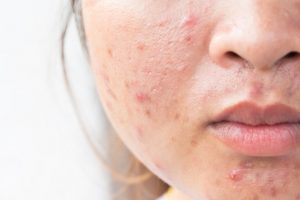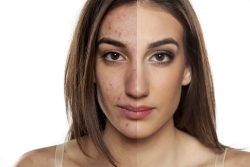For many people, acne is a daily struggle. This uncomfortable skin condition is thought to affect 95% of the population in some way, at some time, but it is particularly rough on adolescents.
Not only can severe acne be incredibly painful at times, but it can leave people with permanent scars. Not great for those youngsters at the most image-conscious time of their lives.
Unfortunately, acne scars are very difficult to get rid of completely, but there are ways to mask and minimize the damage.
For examples of treatment, check out or page on acne scar removal in Bradford.

Table of Contents
ToggleWhat Is Acne?
The symptoms of acne include:
- Outbreaks of spots
- Oily skin
- Skin that’s hot or painful to touch
These symptoms occur on the face in most people, but can also affect the chest and back. The age bracket most at risk of acne is age 14 to 17 for girls and age 16 to 19 for boys.
Symptoms generally improve as a person gets older and disappear in their mid-to-late twenties. It is rare for adults to have acne over the age of 35.
There are two agreed causes of acne: hormones and genetics.
Some inherited genetic mutations mean that a person’s skin is more prone to spots.
Hormonal changes in the body can cause sebaceous glands in the skin to produce more oil (sebum). This abnormal sebum leads to pus and inflammation as well as blocked pores, partly caused by a change in activity of the P. acnes bacteria on the skin.
Acne currently has no cure but can be managed with treatment.
How Do Acne Scars Form?
Acne scars are the result of too much or too little collagen being produced as the skin heals damage caused by acne spots.
Acne scars are usually formed when a spot becomes infected, is picked, or bursts. So don’t squeeze those spots, no matter how juicy the temptation might be!
There are six types of acne spot. Cysts are identified as the most severe and the most likely to cause permanent scarring. These are the large, pus-filled, boil-like lumps. If a cyst ruptures, a scar will be left behind.
The large lumps that build beneath the skin surface – nodules – can also cause scarring. If they are deep and swollen, they can damage the collagen in the skin.
If you have inflammatory acne, where the skin is red and tender, delaying treatment may increase your risk of scarring. Sometimes this type of acne will increase melanin in the skin, causing hyperpigmentation; dark patches on the skin.
Types of Acne scar
There are two general classifications of acne scar: depressed (atrophic) and raised (hypertrophic).
Depressed scars are indents or pock marks in the skin surface and are caused by too little collagen being produced in the healing process. They include:
- Ice Pick Scars – small, deep holes
- Boxcar Scars – wider scars that have a round or oval shape, similar to chicken pox scars
- Rolling Scars – wide depressions that cause an uneven skin surface in an ‘M’ pattern
Hypertrophic Scars are the result of too much collagen being produced in the healing process. They are raised, or elevated, and are common on the chest and back.
Depending on your skin type, treatment for different scars can vary. It is likely that you will need a combination of treatments to effectively diminish your acne scarring. Treatment for scars should only be carried out once the acne has disappeared.

How to Get Rid of Acne Scars: Acne Scar Removal
Chemical Peels
Chemical peels exfoliate your skin, essentially removing the top layer to promote new growth. They have the following results:
- Smooth skin texture
- Lighten dark or pigmented areas
- Unclog pores
- Reduce chance of acne reoccurring
- Typically only need one treatment session
Micro-Needling
Micro-needling involves puncturing the top layers of skin with tiny needles to promote natural healing, stimulating collagen production. This:
- Smoothes skin texture
- Reaches deep scarring
- Takes roughly five treatment sessions
Laser Resurfacing
Laser treatment for acne scarring often employs the use of fractional or carbon dioxide ablative lasers. Like chemical peels, it resurfaces the top layer of skin, masking scars with younger, healthier skin. This procedure:
- Accurately targets specific scars
- Smoothes skin texture
- Is not for all skin types
- Takes 3 to 5 treatment sessions
Dermal Fillers
Injecting a hyaluronic acid or collagen-based product into the skin triggers natural healing that will lessen the depression of atrophic scarring. Most dermal fillers are:
- Localised to targeted areas
- Temporary – last up to a year
Steroid Injections
Injections of corticosteroids are good at treating raised or thick acne scars. They require:
- A series of injections over a few weeks
At-Home Remedies
Over the counter chemical peels are available and there is evidence that they improve acne scarring by encouraging skin cell turnover. They are not as effective for masking raised scars. Consult a professional before use to ensure that the product is right for your skin.
Chemical peels are most successful if they contain: salicyclic acid, glycolic acid, lactic acid, mandelic acid, phytic acid, retinoids, azelaic acid and hydroquinone.
What next?
There are other acne scar treatments out there, ranging from scar removal creams to surgery. Medical treatments are proven to be the most effective at improving the appearance of scarring, but they can be expensive.
You can speak to a licensed doctor or a dermatologist to get recommendations on the best course of treatment for your skin.
Here at the Bradford MySkyn Clinic, our team of qualified specialists can perform a consultation with you to determine what your options may be. Contact us online or call 01274 921121 for more advice and information.



